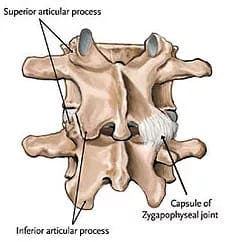If you're experiencing persistent back pain and limited mobility due to facet joint syndrome, the Center for the Functional Restoration of the Spine offers cutting-edge therapies such as facet joint injections and physical rehabilitation to alleviate discomfort and improve function.
Facet Joint Syndrome Q & A
What is facet joint syndrome?
What causes facet joint syndrome?
What symptoms does facet joint syndrome cause?
How is facet joint syndrome treated?
What is facet joint syndrome?
Facet joint syndrome is a condition affecting the joints that link your vertebrae together. You have 33 vertebrae in your spine, with two facet joints between each pair of vertebrae, one on either side. These joints provide spinal flexibility and stability. The facet joints possess a cartilage layer that ensures there's no friction between the bones as they move. There's also a membrane (synovium) that lubricates the joint with synovial fluid. If the facet joints are irritated and inflamed, it can cause pain and other unpleasant symptoms because the nerves serving the facet joints become compressed. This condition is known as facet joint syndrome.
What causes facet joint syndrome?
The inflammation that triggers facet joint syndrome could be due to:
- Infection
- Osteoarthritis
- Degenerative disc disease
- Synovial facet joint cyst
- Degenerative spondylolisthesis
The effects of aging, acute or repetitive trauma, and poor posture can contribute to the development of facet joint syndrome.
What symptoms does facet joint syndrome cause?
Your symptoms depend on the location of the affected facet joints:
Neck (cervical spine)
Facet joint syndrome in your cervical spine can cause neck pain that often radiates out into your shoulders and arms. You might get frequent headaches and find it very difficult to turn your head.
Lower back (lumbar spine)
Facet joint syndrome in your lumbar spine can cause lower back pain that can spread into your buttocks and legs. You might find it difficult to walk or stand. The first step in diagnosing facet joint syndrome is for the Center for the Functional Restoration of the Spine team to look at your medical history, review your symptoms, and conduct a thorough physical exam. They look for limited movements in your spine and test your muscle strength and reflexes to look for nerve damage. Following your exam, you might need to go for further tests such as X-Rays, a CT or CAT scan, an MRI scan, and a facet joint block.
How is facet joint syndrome treated?
Several non-surgical therapies can relieve both the inflammation and pain present in facet joint syndrome, including:
- Posture correction
- Activity modification
- Exercise and physical therapy
- Non-steroidal anti-inflammatory drugs (NSAIDs)
- Prescription pain relief
- Steroids
- Muscle relaxants
- Facet joint block local anesthetic injection
If these treatments aren't proving effective, surgery might be necessary. Options include laminectomy to widen your spinal canal, spinal fusion to stop the facet joints from moving, and radiofrequency rhizotomy to destroy the nerves in your facet joints. If you're struggling with symptoms of facet joint syndrome, call the Center for the Functional Restoration of the Spine team or book an appointment online today.







